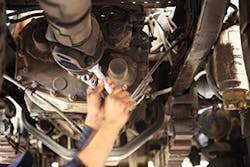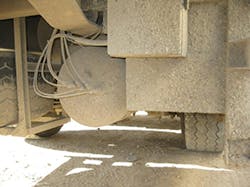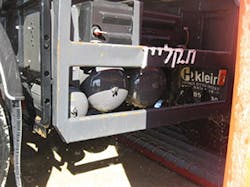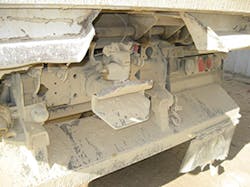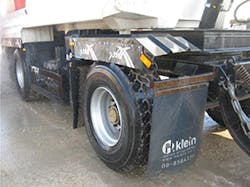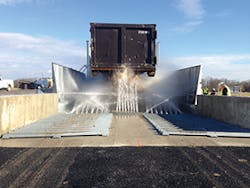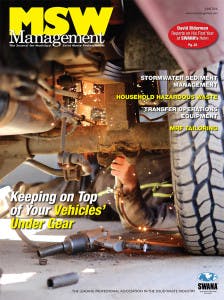While a lot of attention is usually paid to parts and equipment on solid waste vehicles that are high up and visible, it is important to pay attention to what is underneath and not so visible. Products and equipment include transmissions, suspension systems, brakes, and wheels.
Transmissions
One new product on the market for solid waste vehicles is Parker Hannifin’s RunWise, an advanced series hybrid drive system, which is designed to significantly reduce fuel consumption and operate efficiently for urban routes during refuse collection. “By combining hydraulic components, advanced control software, and brake energy recovery technology, more than 70% of a vehicle’s otherwise lost brake energy is recovered,” says Angelo Caponi, a sales specialist for the Hybrid Drive Systems Division of Parker Hannifin Corporation. “This stored energy is reused, saving fuel, to power the truck during collection routes.”
Thanks to the regenerative braking, trucks equipped with RunWise see a reduction in brake wear of up to 97%, or one brake change over a 10-year life of a truck. An added benefit is smoother and quicker acceleration and braking when compared to standard diesel.
According to Caponi, users of RunWise have been anywhere between 5 and 15% productivity increases when compared to the standard diesel truck that the Hybrid replaced.
The major subsystem of the Parker RunWise system is a power drive unit (PDU) that contains three gears, equipped with two different drive modes—mechanical and hydraulic. The mechanical mode is used for highway efficiency.
When in the hydraulic mode, the PDU operates with the hydraulic fluid supplied through the secondary pump/motor to drive the truck in hydraulic-low and hydraulic-high. The secondary pump/motor receives the hydraulic fluid from the high-pressure accumulators. “The system always monitors the accumulator’s state of charge to ensure optimum performance,” says Caponi. The truck operates in hydraulic-low function from 0 to 25 mph, and in hydraulic-high function from 25 to 44 mph.
Currently, there are nearly 200 trucks with 30 fleets and municipalities in the US equipped with the RunWise hydraulic transmission. “With approximately 3.3 million miles of service completed, the fleet average for fuel savings is 43%,” says Caponi.
One satisfied customer of Parker-Hannifin’s RunWise Hydraulic Hybrid Transmission System is the Fleet & Facilities Management Division of the City of Orlando, FL. The department was looking for alternatives to make its solid waste vehicles more environmentally friendly. “Originally, we were looking at CNG as an alternative fuel to diesel,” says Daryl Greenlee, fleet manager. “However, there was no infrastructure in central Florida at the time to support CNG, such as open fueling stations.”
The department then heard about Parker-Hannifin’s RunWise Hydraulic Hybrid Transmission System. “When Miami-Dade introduced six of these units, I started getting weekly feedback from them on fuel consumption, brake measurements, et cetera,” says Greenlee. “Because of the good results they were getting, we decided to demo a unit.”
An initial cost was a concern, so the department conducted a lifecycle cost analysis with the information it was receiving from Miami-Dade. “We made some projections and decided to go ahead with four units about four years ago,” he says. “We noticed a significant reduction in fuel consumption right out of the gate. In fact, this past year, one of our drivers was recognized as having the greatest reduction in fuel consumption of any driver in the nation using this transmission system—62%. He learned how to work the truck, and let the truck work for him.”
In addition to fuel savings, the department hasn’t had to do a brake job on any of the units yet. “Typically, we do three to four brake jobs a year on our other units,” says Greenlee. “We estimate a savings of about $12,000 a year on each unit in brake work alone.” Over a 10-year life cycle, that comes to $120,000 savings, and that doesn’t even include the fuel savings.
“And, because the engine runs at a constant speed, our service intervals have increased, which also reduces our oil consumption,” says Greenlee.
Another benefit is that the department is getting about eight months out of each tire, rather than the standard six, as a result of reduced skidding and less-aggressive turning.
Over the years, the department has continued to add new units, and, by the end of March 2016, it had a total of 30 units, which represents about one-third of the department’s fleet.
Another transmission manufacturer offering new features is Allison Transmission. “Allison Transmission is the world’s largest manufacturer of fully-automatic transmissions for medium- and heavy-duty commercial vehicles,” says Craig Koven, manager, communications and media relations for the company.
Allison’s fully automatic transmissions, known as Allison Automatics, are designed and built to perform at peak level every day. “Our transmissions make refuse trucks better by improving fuel efficiency, simplifying operation, and improving safety,” says Koven.
One of the additional features that Allison Transmission offers is FuelSense, a set of packages of software and electronic controls for a variety of Allison fully automatic transmissions, which are designed to improve fuel economy. “Your fleet could realize fuel savings of up to 20% and still get the ease of operation and dependability you expect from Allison,” says Koven. FuelSense comes in three packages—FuelSense, FuelSense Plus, and FuelSense Max.
Basic FuelSense includes new 5th Generation Electronic Controls that are designed to improve fuel economy. Components include additional levels of acceleration management and a precision inclinometer to optimize shift scheduling. The 5th Generation Electronic Controls also maximize transmission protection with advanced diagnostic and prognostic displays that anticipate maintenance needs, while maintaining peak performance.
Basic FuelSense also includes EcoCal, which is designed to lower engine speed. Lower shift points provide better fuel economy and maintain vehicle performance without shift cycling. Working in conjunction with EcoCal is Dynamic Shift Sensing, which automatically selects between the EcoCal, or a higher-speed shift schedule, based on the vehicle’s weight and the surface operating grade. Dynamic Shift Sensing allows for superior performance, while maximizing fuel savings.
FuelSense Plus includes 5th Generation Electronic Controls, EcoCal, and Dynamic Shift Sensing. It also adds Neutral at Stop, which eliminates the transmission load on the engine to reduce non-productive fuel consumption when the vehicle is stopped. Two levels are available, which allow users to customize FuelSense to their needs. The standard option allows for reduced load while stopped, with locked output to help prevent rollback. The premium option provides full Neutral at Stop capabilities. For vehicles with a high start/stop duty cycle, the Neutral at Stop function provides the necessary technology for improvements in fuel economy.
FuelSense Max includes 5th Generation Electronic Controls, EcoCal, Dynamic Shift Sensing, and Neutral at Stop. It also adds Acceleration Rate Management. Aggressive driving can cut into fuel economy and reduce fleet efficiency. Acceleration Rate Management addresses this issue by automatically controlling the engine torque. The level of control is determined by the vehicle’s weight and the grade on which it is operating. Combined with the other features of FuelSense, Acceleration Rate management helps maximize fuel savings.
Suspension Systems
Hendrickson’s HAULMAXX suspension has been in production for more than 10 years and has a reputation as a durable but lightweight suspension for refuse vehicles, living up to the demanding requirements of that market. “Specifying HAULMAXX takes hundreds of pounds out of the overall vehicle weight,” says Gerry Remus, director of Marketing for Hendrickson Commercial Vehicle Systems.
Recently, though, the company improved the HAULMAXX suspension with the introduction of a Progressive Load Spring (PLS), an elastomeric spring that works in concert with the bolster springs in Hendrickson’s patented Vari-Rate Spring system, providing ride quality in both the loaded and unloaded conditions. “The PLS improves the HAULMAXX rear suspension system by providing advancements in ride quality and stability,” says Remus. “The PLS is continuously engaged, providing excellent unloaded ride performance.”
As payload increases, the spring further engages and functions together with the rubber bolster springs to provide additional stability. The PLS is constantly engaged, which eliminates the need for shim adjustments for most applications, resulting in reduced maintenance and costs.
This new product has launched and is performing in the field at a variety of refuse customers. “The initial response from customers is positive, and they report that the difference in overall ride quality is noticeable,” says Remus.
Another new product from Hendrickson is the PRIMAAX EX suspension, which is a heavy-duty air suspension system designed specifically for heavy-duty applications. “In the past, air suspension was not adequate for solid waste vehicles, because it didn’t provide the necessary durability, stability, or articulation,” says Remus.
PRIMAAX EX delivers the durability and performance required for certain applications in the sold waste market. According to Remus, applications like roll-offs and rear loaders can benefit from the improved ride quality and equipment protection that an air ride provides with a product that is ideal for this rugged application.
There are more than tires and brakes to monitor (before)
The Air Link Tandem Drive Suspension from Link is a unique combination of air spring and walking beam technology, providing the refuse industry a solution that ensures superior traction and load equalization when the load is full, without the bone-jarring ride when empty.
Originally constructed to meet the demands of the Western Canadian logging industry, Air Link is the only air spring suspension designed specifically for severe service on/off highway vehicles, including refuse trucks. It has been proven to lower operating and maintenance costs, reduce damage to chassis and mounted equipment, lengthen tire life, and reduce downtime.
The Air Link walking beam design allows great articulation for both the street and the dumpsite/transfer station; the polyurethane bushings are more resistant to damaging winter road chemicals than rubber bushing options; and the air suspension enables drivers to maintain the same ride quality throughout the vehicle route and loading. The air springs can also be dumped to reduce chassis height and provide greater clearance. Yet with their integrated jounce bumpers, the suspension is still fully functional in that dumped state. Air Link is available in 46,000- and 52,000-pound capacities.
There are more than tires and brakes to monitor (after)
Brakes
In 2010, Webb Severe Duty had a line of standard Vortex drums, but the company didn’t see anything in the market that focused on heavy-duty applications for refuse applications, which generate a lot of heat in normal operation, due to the high number of stops on a route.
“We talked to haulers and owners of Automated Side Loaders, residential front loaders, commercial front loaders, and even rear loaders, and learned that they can go through a lot of brake jobs in a year,” says Jeremy Zills, manager of engineering for Webb Severe Duty. “Additionally, we learned that there are a lot of heat-related tire failures. Refuse haulers are spending a lot of money on brakes and tires on high-use trucks.”
The company began working worked with several haulers and instrumented several of their refuse vehicles under various conditions with thermocouples and electronic monitoring equipment. “We pulled all of the braking events, including the time between braking events, brake pressure measurements, and various temperature events on drums and on friction material,” says Zills.
Using this data, the company was able to create drums with an optimized mass-to-surface area for maximum heat dissipation, called Webb Vortex Severe Duty Brake Drums.
“Traditional drums have a squealer band positioned at the open end of brake drums,” says Zills. “Ours has a band that is located on the center of the braking surface, and has heat dissipation ribs coming off either side of that band, which dissipate heat much faster than traditional drums. In fact, these drums run up to 22% cooler than standard drums.”
More before activity
The company tested these in the field over several years and applications, running them against standard drums for weeks at a time. On average, results showed that the Webb Vortex Severe Duty drum can provide 35% longer run times than standard drums. “The reason is that keeping friction material cooler can dramatically increase the life of the friction,” says Zills. “Some users have also claimed a reduction in heat-related tire failures while using these brake drums.”
Many refuse vehicles go through multiple brake jobs a year with traditional brake drums. Severe Duty drums reduce the number of brake jobs, which ultimately leads to cost savings for the fleet.
Another benefit is that, when brakes get too hot, drivers can experience brake fade, meaning they don’t operate as efficiently as they should. “This can be a real safety problem if a driver is going downhill, and the brakes fail because of brake fade,” says Zills. “Drivers tell us that our drums help their brake operate better throughout the day, with much less brake fade.”
More after activity
One satisfied customer is Jim Schooler, owner of Dillon Disposal (Roanoke, LA), which operates four trucks a day, four days a week, to serve 4,000 rural residential customers. “Fifty percent of our routes are gravel roads, and we have a lot of frequent stops, since we don’t have any commercial customers, so we were having a lot of brake trouble,” says Schooler. “Another problem was, driving on dusty roads, a lot of dirt and dust would get into the brakes, causing which caused them to squeak and heat up even more. We were having to change brakes every four months, which, of course, is not only a major problem, but gets very expensive.”
One of Schooler’s friends told him about Webb Vortex Severe Duty Brake Drums. “I’ve been in this business 30 years and heard all kinds of stories about ‘miracle’ products, so I didn’t think too much about it at first,” says Schooler. However, he was able to get a sample set for each of his four trucks, and he installed them on the backs of each of the trucks.
“They made me a believer,” he says. “It’s been nine months and I haven’t had to change brakes or brake drums even once, and they still have about half of the brake pad on them so I expect to get well over a year out of them.”
In addition, blowouts and tire repairs have decreased about 75%. “Heat is the worst thing for a tire, especially down here in Louisiana, where it gets over 100 degrees in the summer,” he says. “These brake drums generate almost no heat at all.”
Schooler notes that has been so happy with them that he plans to order some for the fronts of the trucks. “This time, I plan to pay for them, because they are definitely worth it,” he says. “I’ll never use any other kind of brake drums again other than these.”
While repair and replacement costs have decreased significantly for Schooler, the drivers like the new brake drums, too, primarily because their trucks are now almost always available every day, rather than in the shop for brake or tire work. “On days when they can’t drive their regular trucks, they have to use one of the old spare trucks, and they really don’t like having to drive those,” he says.
Moby Dick 13 foot wide with undercarriage truck
Wheels
Alcoa has been designing, producing and marketing forged aluminum wheels for medium and heavy-duty truck applications since 1948. “We invented the aluminum industry and the forged aluminum wheel,” says Brian E. Thomas, marketing communications manager for Alcoa Wheel and Transportation Products.
Today, the company offers wheel products that lower vehicle weight for better efficiency, improved load capacity, and better fuel economy; reduce maintenance costs, including less up-keep, curbing damage, etc.; do not need to be sandblasted or repainted as often as steel wheels; do not rust, thus improving the image of the fleet; and clean easily with mild soap and water (as a result of the company’s proprietary Dura-Bright surface treatment).
“We currently market the lightest wheels, including 22.5-inch-by-9-inch applications that are popular on nearly all refuse trucks in North America,” says Thomas. “These wheels offer a 10,000-pound load rating and weigh just 51 or 59 pounds, depending on application. They are currently several pounds lighter than what the competition offers, and more than 50 pounds lighter than a comparable steel wheel.”
In addition, all of the company’s aluminum wheels are offered in various finishes. “We market Clean Buff and Mirror Polish, in addition to the Dura-Bright Surface Treatment,” says Thomas. “This option is appropriate for image-conscious fleets and those looking to reduce maintenance costs and time.”
Finally, all of the company’s aluminum wheels are the lightest in their respective class within the industry. However, they are also designed with a thicker mounting flange (interface of the wheel to the hub) compared to steel wheels. “A thinner mounting flange improves fastener torque retention and reduces wheel-offs,” says Thomas. “Maximizing fastener grip length improves torque retention. We have worked with major refuse fleets that have had wheel-off issues and helped them solve these safety problems.”
Tires
Goodyear recently introduced the Goodyear Endurance WHA, the company’s longest-wearing waste haul tires. The tires offer more miles to removal than any previous Goodyear waste haul product as a result of a new, scrub-resistant compound and a deep 24/32-inch tread depth. “Goodyear wants to help waste haul fleets lower their operating costs, and the new Endurance WHA will do just that by offering more miles to removal and other important benefits,” says Andrea Russell, brand manager, Goodyear Commercial Tire Systems.
Optional with the Endurance WHA is Goodyear’s DuraSeal Technology, which is built into the tire during the manufacturing process and seals nail-hole punctures of up to 1/4-inch in the repairable area of the tire’s tread. “Goodyear is the only tire company that offers a built-in tire sealant, which is of tremendous benefit to waste haul trucks that roll across debris-strewn surfaces at dumps and waste transfer stations,” says Russell.
The Goodyear Endurance WHA also features sideware protector shingles to help resist sidewall scuffing in high-scrub applications, an optimized shoulder design to promote uniform wear, and a wide footprint to enhance cornering and handling. Goodyear also offers a matching retread for the Endurance WHA.
Cooper Tire & Rubber Company added to its Roadmaster line of commercial tires with an entry designed specifically to withstand the demands of sanitation trucks. The new RM230 WH is an all-position waste-haul tire available in size 315/80R22.5, with load range L. “We designed the tire specifically with the steer position in mind, since the life expectancy for many steer tires on sanitation trucks is often gauged in months, not miles,” says Gary Schroeder, Cooper’s director of commercial vehicle and OEM sales. “For sanitation operations, tires are often the biggest expense, surpassing even fuel in some severe applications.
The Roadmaster RM230 WH is an inch wider than its predecessor, with a 20% larger footprint than any previous Roadmaster waste-haul tire. “The wider footprint helps evenly distribute the weight on this tire to enhance tread life,” says Schroeder. “When you have up to 10,000 pounds per tire riding on that footprint, and constant scrubbing and curbing, bigger is better.”
The Roadmaster RM230 WH also features a stone protector ledge in the center groove of the tire to help guard against stone penetration, preserving casing retreadability. The tire also features a high-tensile strength four-belt package to aid in retreadability.
Wheel Wash Systems
The MobyDick HD1 Maintenance Wash is a drive-through washing system, which includes a manual wash function. The wash is designed to provide a thorough clean for jobsite equipment and at maintenance facilities. A coordinated system of fixed and oscillating spray jets applies MobyDick’s high-volume/low-pressure technique to automatically clean undercarriage, fenders, tires, and tracks subjected to heavy muck conditions.
To access additional case studies and in-depth reporting, check out the June edition of MSW Management.
You may need to log-in or subscribe to our magazine.
